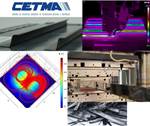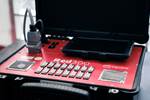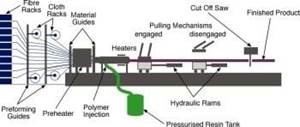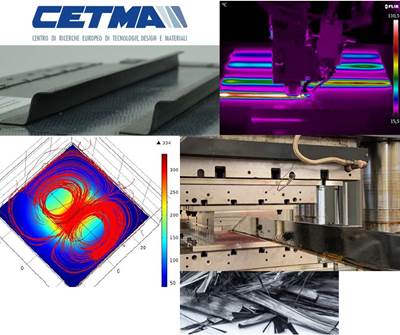Using a Corebon induction-heated mold (top left), Alia Mentis applied its Koridion expandable core (top right) to produce a Class A finish carbon fiber-reinforced polymer (CFRP) hood with integral air ducts and complex geometry. Source (All Images) | Alia Mentis
Koridion is an expandable core material and process for carbon fiber-reinforced polymer (CFRP) parts developed by the innovation firm Alia Mentis (Montebelluna, Italy). It was launched at JEC World 2023, where a variety of parts were exhibited, including a one-piece hood with integral air ducts and Class A clear carbon fiber finish. This demonstrator part also served to help mature a new forming process that integrates the Koridion core using a pressclave and tools equipped with induction heating by Corebon (Malmo, Sweden).
“That car hood [displayed at JEC] was made in 15 minutes using the Koridion active core, with no bonding of the structure to an outer shell as manufacturers currently do,” notes Giuseppe Paronetto, CEO of Alia Mentis. “But thanks to Corebon and our new integrated pressclave system, that same car hood can be completed in 8 minutes with energy consumption reduced by 90%.” This system uses a lightweight, thin shell tool as a high-tech mold, he notes. “Powered by Corebon’s induction technology, we combine this with the Koridion active core for a highly efficient and fast process that reliably produces complex geometry parts with uncompromised quality — from CFRP parts that manufacturers told us were impossible or too expensive to make.”
“Parts that we started developing 3-4 years ago with car manufacturers,” says Patrick Caseley, marketing manager at Alia Mentis, “are going into production now.” And the company is not just working with OEMs and Tier 1 suppliers, but also with leading prepreg producers and material suppliers worldwide. “They have become our partners, adding their materials knowledge to exploit the nature of the resin system and textiles with our customizable core at a deep level to change the way CFRP is made — a process that is easier, simpler and more sustainable.”
Koridion active core molding
Alia Mentis develops materials science innovations including new processes and paradigms to help designers and manufacturers revolutionize their products in a range of industries including medical, aerospace, automotive, sports and industrial.
Koridion’s development started 11 years ago, Caseley explains, “as a new answer to the question of how to avoid limits in the CFRP transformation process.” These limits included how to make more complex shapes while also avoiding the use of autoclaves, vacuum bagging, inflated bags to create local pressure and the associated issues and cost.
This hydrofoil wing demonstrates how Koridion active core technology enables forming of internal stiffeners, helping to reduce CFRP plies by 30-40% for very lightweight yet durable high-performance structures.
“The Koridion active core technology enables one-shot structures which are impossible to make with conventional CFRP processes,” says Paronetto. “We place prepreg and preshaped Koridion core inside a compression mold, and curing activates the Koridion material expansion, which applies equalized pressure all along the cavity. This moves fibers into the correct place against the mold and also forms internal stiffeners in a single step.”
“Pressure solves a lot of problems” goes the old adage in composites. Alia Mentis demonstrated how this is borne out in the Koridion process. “We asked a technician to make a very bad layup,” says Paronetto. “You could see wrinkles, bad cutting and detached plies everywhere. This part would have been scrap, but instead, using our process, the interferences, overlaps and wrong shapes were pushed into the correct position by the Koridion core with equalized pressure. All the edges, undercuts and radiused areas in the final part were perfectly formed with no marking on the surface.”
Further, the ability to simultaneously form internal stiffeners not only results in integrated structures without curing and bonding multiple parts, but also reduces the amount of CFRP required. “You can see the strength of these internal elements in kiteboard hydrofoil wings that we’ve made,” says Caseley. “These parts are under a huge amount of force when people start jumping waves with them. Traditionally, there were problems with breakage and this integrated structure virtually eliminates breakage while reducing weight.”
CFRP kiteboard and hydrofoil structures made using Koridion active core molding featuring integrated stiffeners
“Koridion enables reduced weight in wings, car hoods, roofs and various structural frames,” says Paronetto. “At least 30-40% of the CFRP layers can be removed, which saves a lot of money, but it also saves time, labor and energy as well.” He notes labor savings can easily be 50%. “And carbon fiber as a material is not currently sustainable — for every kilogram of CFRP, 30-35 kilograms CO2 equivalent is produced. This is also what you remove by using less material. And the resulting Koridion structures also enable lightweight vehicles, which can go further with less fuel and emissions.”
“Koridion produces high-performance parts with a reduced quantity of carbon fiber and CO2 emissions,” Paronetto summarizes. But doesn’t the core material itself add weight? “It is soluble, so you can remove it. But at 23 kilograms per cubic meter, it is often better to leave it and maximize buckling resistance.” This is a fraction of other lightweight cores. For example, lightweight Nomex honeycomb used in marine and motorsports applications can be as low as 48 kilograms/cubic meter (3 pounds/cubic foot), while recycled PET and Corecell foam cores for composites typically start at 60-90 kilograms/cubic meter.
Customized expandable materials
Paronetto points out that Koridion should not be confused with foam cores nor with syntactic foams and epoxies, which have been used for decades. “Expandable materials are not new,” he agrees. “But our material is different because we produce tailor-made formulations that consider the key parameters in the molding process for each project.”
The first parameter is pressure. “To form complex shapes, you have to compact the layup before the gelling point of the resin,” explains Paronetto. “We develop the chemical formulation of the core to match the viscoelastic behavior of the resin in order to produce the required pressure and compaction at the right time.” Koridion can reportedly apply up to 12 bar of pressure during active core molding. However, that behavior must also be matched with the layup’s thickness and geometric complexity.
“We are also going to match the resin system’s cure cycle,” he adds. “We adapt the Koridion chemical formulation to match the process recommended by the resin manufacturers, which also includes cure time. We can accommodate a typical resin that cures in 1 hour at 130°C or a snap-cure resin processed at 230°C and cured in minutes.”
“This is why our results weren’t achieved with other expandable systems,” says Paronetto. “Because CFRP molding is quite complex and it’s really not possible to have just one compound that fits all needs. So, there is no catalog for Koridion, but instead it is customized to deliver equalized pressure within the volume of each part, per that part’s optimized process variables.”
Compatibility with thermosets and thermoplastics
Koridion is a thermoplastic material, currently being used with epoxy resins and prepregs. “This has been our target because we have mostly developed applications in the sports, high-end automotive and military sectors,” says Paronetto. “But Koridion can also be compatible with phenolic and polyester resins. And we are now collaborating with major prepreg producers to develop formulations that are compatible with thermoplastic prepregs.”
He notes that with thermoplastic materials, the part’s shape is formed with heat and must be maintained through the cooling process. “This is when the material is at risk to shrink, but we don’t want that. So, that is part of the know-how we have developed with our material, and we also have a very broad series of experiments and lab tests with the main brands of thermoset and thermoplastic prepregs and resin systems worldwide.”
“We want to continue to make the Koridion molding process easier and more sustainable,” says Paronetto. “To achieve this, it is mandatory to exploit the nature of the resins, textiles and Koridion core at a deep level. So, we are working with key players in the composites market to develop high-tech solutions with a good level of integration.”
Car hood demonstrator
One of the industry players Alia Mentis is collaborating with is Corebon, targeting more efficient heating and cooling. “They reached out to us through a common contact and had the need to quickly cycle tools,” says Kenneth Frogner, head of R&T at Corebon. Paronetto explains that induction heating is well-known for efficiency and energy savings. “The issue is how to use it with composites cost-effectively and reliably.”
Car hood demonstrator with high level of cosmetic finish (top), underside of finished hood (center) and close-up of complex geometry (bottom).
The two companies began working together to adapt Corebon’s induction-heated tools and press plates to the Koridion materials and process. One result was a car hood demonstrator, its Koridion core and induction heated CorePlate Adapt tool (see online sidebar “Corebon induction heating”) displayed at JEC 2023.
Why a car hood? “It’s an easily recognizable part that is extremely difficult to make,” says Caseley. “People who make cars came up and said, ‘How did you do that?’ They know they can’t currently make a hood that big or complex with such high quality. It has complex edge geometry and integral air ducts made with the part in one shot. It’s also incredibly light and strong, with a high level of cosmetic finish.”
“The hood was made with a very lightweight metal shell tool,” adds Frogner. He explains that lightweight CFRP tools can be made with prepreg, “but this was a tool for compression molding and included induction heating.” It can be seen in the opening image and in the Koridion video online (Learn More), where the upper and lower parts are bolted together. Caseley adds, “And it was made to maintain the same thickness throughout, so that the induction system heats it up very rapidly.”
“We worked together on the tooling for the car hood demonstrator,” says Frogner, “and have also supplied equipment that offers a generic solution for versatility in use. Now, we’re discussing how we can take the next step and target applications which really need high speed and where we can optimize the tools to reduce the mass, which further lowers cycle times so we can scale both in terms of production volumes and the number of different parts possible.”
K1 process
The car hood demonstrator was also a means for advancing a new processing system that Alia Mentis calls “K1.” The process uses tooling with Corebon’s induction heating and a pressclave system in a CDG (Carré, Italy) press machine with multiple means for cooling, including water shower and immersion.
“The machine brings together what is good from the autoclave and what is good from the heated press,” says Paronetto. “First, we were looking for an automatic system able to take the shell mold and maintain control of the geometry. Second, we wanted the best way to avoid gaskets and sealing systems yet still guarantee the vacuum action to extract the air — so, this was integrated into the press machine. Third, we were looking for the best and safest way to use induction heating as provided by the Corebon system and apply this to the 3D shell mold within a system able to manage it with simplicity and economy.”
“This combination has enabled a new way to produce complex parts,” says Paronetto. “We have a highly efficient and fast process with reliable control of the part dimensions, shape and surface quality. Plus, we have the freedom to set the speed of the heating and cooling. For a thin steel shell mold, heating can reach 50°C per minute. But you can set it slower and also tailor the cooling.”
“This also matches the concept of sustainability we have with Koridion core,” he adds. “We want the minimum material in the mold and only where we need it.” This reduces thermal mass and the energy required to heat and cool the tool, adding to the already large reduction from using Corebon’s induction technology. “We can reduce energy consumption by 90% compared to conventional CFRP processes,” says Paronetto. “We made a calculation for the car hood, and we can reduce cost from €40 down to €1.6 per part.” This includes hours of processing in the pressclave versus autoclave, as well as labor for vacuum bagging and the cost of those consumables versus the pressclave. “And thanks to this new integrated process,” he adds, “that same car hood can be molded in 8 minutes.”
Class A preforms, 3D printed molds
Paronetto says Alia Mentis is also working with prepreg producers on how to prepare layups with inserts as preforms that can be placed into the induction-heated molds and formed quickly while still achieving a Class A surface. “We are preparing together with some OEMs and Tier 1 suppliers to have the first production of complex parts — for example, a hood or roof that has a cycle of roughly 20 minutes. After removing this part from the mold, you reload by just placing a new preform into the mold, close it again and activate the press machine to make another part.”
Caseley points out that these 3D shell molds Paronetto referred to above are actually being developed to be 3D printed. “And this gets very interesting, because we dramatically reduce the time and waste of machining a block of aluminum into a mold by printing it to the correct thickness.” But don’t you still have to machine the mold for Class A parts? “Yes, but it’s a fraction of the time and cost versus current moldmaking,” he says. “And we then integrate the Corebon induction technology and put it into the K1 pressclave system.”
Revolutionary system, future parts
Alia Mentis will exhibit this revolutionary system at JEC World in 2025, says Paronetto. “We will also introduce the new generation shell molds powered by Corebon and the new moldmaking department at Alia Mentis which will make these 3D shaped molds to feed the market that is already demanding these new systems.” Frogner adds these will implement Corebon’s new automatic inductor design and manufacturing concepts. “That will also be a key technology in the ability to scale up to large numbers of parts per month,” he explains.
“We will be making real-time demonstrations to OEMs over this summer and autumn,” says Paronetto. “Our first target is to complete the validation process with a key OEM, and then work to implement the new part manufacturing system into Tier 1 production lines.”
What kind of parts will this new process be able to radically change in the future? “It has taken us almost 12 years, but now car manufacturers want to speak to us before they start designing cars,” says Caseley. “They can make new shapes that were never possible before. This is a purely industrial design-related conversation that we’re having on the capability of this new material and process. And then we work together on how best to implement it. So, it’s a whole new mentality.”
“We’re also being contacted by manufacturers of drones and UAVs,” he continues, “where the move to electrification is driving the need to reduce weight. And there are also companies producing various types of passenger aircraft. But you can apply this to any type of structure. It's not the cheapest technology, but it provides good value for high-performance products.”
“We developed Koridion to transform carbon fiber into high-performance CFRP parts in a different way,” says Paronetto. “We are finally unblocking bottlenecks and enabling new, even more complex shapes with reduced material, weight and energy consumption. But it’s more than just these benefits. It’s a totally new way to develop composite parts that is unlocking freedom in design and production and what is possible.”
Related Content
Plant tour: Joby Aviation, Marina, Calif., U.S.
As the advanced air mobility market begins to take shape, market leader Joby Aviation works to industrialize composites manufacturing for its first-generation, composites-intensive, all-electric air taxi.
Read MoreLarge-format 3D printing enables toolless, rapid production for AUVs
Dive Technologies started by 3D printing prototypes of its composite autonomous underwater vehicles, but AM became the solution for customizable, toolless production.
Read MorePultrusion: The basics
A primer describing what pultrusion is, its advantages and disadvantages, and typical applications.
Read MoreThe potential for thermoplastic composite nacelles
Collins Aerospace draws on global team, decades of experience to demonstrate large, curved AFP and welded structures for the next generation of aircraft.
Read MoreRead Next
“Structured air” TPS safeguards composite structures
Powered by an 85% air/15% pure polyimide aerogel, Blueshift’s novel material system protects structures during transient thermal events from -200°C to beyond 2400°C for rockets, battery boxes and more.
Read MoreCETMA: composites R&D and innovation in Italy
From design and simulation to inline inspection, induction welding, continuous compression molding and recycled carbon fiber, this lab to support industry is advancing composites in aerospace, automotive, construction and more.
Read MoreFlexible, induction-based heating for thermoplastic composite part repair
Spinning off from a German Aerospace Center (DLR) research project, msquare GmbH’s technology aims to innovate and enable repair for high-temperature thermoplastics.
Read More


































